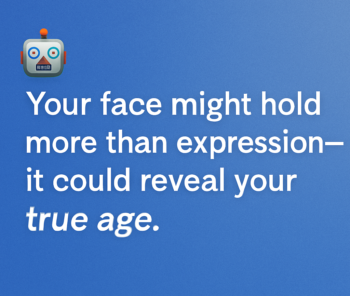Artificial intelligence (AI) continues to push into new corners of healthcare, offering tools that promise faster, smarter, and sometimes more equitable decisions. An emerging technology gaining attention is the use of AI to estimate a person’s biological age based on facial features.
But as with many AI-driven tools in medicine, the excitement that comes with the use of such a system that would provide us with an estimate of our biological age also comes with questions: How accurate is this system? Is it fair? And is it ready for real-world use?
What Is Biological Age—and Why Does It Matter?
Chronological age tells us how many years someone has lived. Biological age, on the other hand, refers to how old a person’s body seems based on signs of wear and tear. This difference matters—especially in clinical decisions where physical resilience is a factor.
Doctors already use a variety of measures to assess health status, particularly in older or seriously ill patients. Tools that can estimate biological age may add another layer of insight—especially when deciding on treatments that carry risks, such as surgery or chemotherapy.
The Rise of Facial Analysis in Medicine
Facial analysis systems that are being used to evaluate biological age work based on an analysis of facial images. These analyzed images are input to a model that estimates how “old” a person appears biologically. Early research suggests it may offer useful clinical data—and potentially do so without introducing significant racial or gender bias.
But that’s a cautious “may.” These technologies are still being studied and, like all AI systems, will need to prove itself in diverse real-world settings before it can be fully trusted or adopted.
A Tool—Not a Verdict
When used carefully, AI has the potential to support, not replace, medical decision-making. In this case, facial analysis could one day help doctors better understand which patients are more likely to benefit—or face harm—from certain treatments.
But as with any medical technology, context is everything. Biological age should never be the only factor guiding care, and the ethical risks of misusing this data are real.
The Importance of Responsible AI
Any tool that relies on facial recognition or predictive algorithms must be built and tested with attention to bias, consent, and transparency. History has shown that algorithms trained on skewed or incomplete data can lead to serious inequities in care.
While AI facial analysis systems may show encouraging signs, the future of these tools will depend on how carefully we scrutinize and regulate their development.
Final Thoughts
The growing role of AI in healthcare raises exciting possibilities, including more personalized and equitable treatment decisions. But innovation must come with caution. Facial analysis technologies that are used to estimate biological age are not a cure-all. They are a test of how well we can blend clinical insight, data science, and human judgment to improve care without compromising fairness.
In the end, it’s not about how a face looks—it’s about how we use the information behind it.
What are your thoughts on the use of AI to support clinical decision-making? How much do you trust Artificial Intelligence?





0 Comments